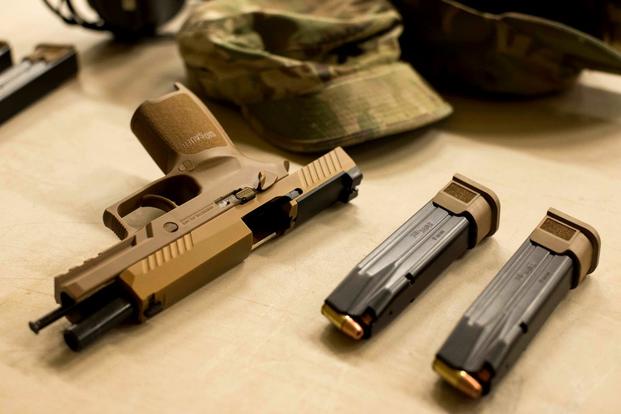The pistol the U.S. Army chose to become its new Modular Handgun System failed reliability requirements during testing while firing the Defense Department's most common type of 9mm ammunition, according to a new Pentagon report.
The Office of the Director of Operational Test and Evaluation recently released its fiscal 2017 report, criticizing the Army's XM17 and XM18 MHS models, made by Sig Sauer, for their performance firing 9mm ball ammunition during the Product Verification Test.
The Army's MHS requirement called for the pistol to use ball ammo, as well as a new special-purpose, jacketed hollow point ammo.
Both MHS variants performed well when firing the new special-purpose ammunition but failed to meet portions of the MHS reliability requirements when using ball ammunition during product testing, the report shows.
"Both the XM17 and XM18 pistols experienced double-ejections where an unspent ball round was ejected along with a spent round," the report states. "Due to the increased frequency of occurrence during Product Verification Test (PVT), the Army stood up a root cause analysis team to identify the cause of the double ejections."
Related content:
- Army Explains New Dual-Arming Policy for Modular Handgun System
- Army Picks Sig Sauer's P320 Handgun to Replace M9 Service Pistol
- Dismissal of Bid Protest Clears Way for New Army Sidearm
In addition, neither variant met the reliability requirement that calls for MHS to demonstrate a "95-percent probability of completing a 96-hour mission without a stoppage" during Initial Operational Test & Evaluation, according to the report, which first appeared in a story on The Drive.
Sig Sauer officials would not comment on the report and referred all questions to Program Executive Office Soldier.
"The DOT&E report accurately conveys the test results," said Debra Dawson, spokeswoman for PEO Soldier. "It is normal and expected during testing to find opportunities to improve a system."
The Army awarded Sig Sauer the MHS contract, worth up to $580 million, in January 2017.
The service received a Conditional Materiel Release for the XM17 and XM18 in November 2017 and has already starting fielding to units from the 101st Airborne Division (Air Assault) at Fort Campbell, Kentucky.
Ongoing Analysis
Analysis is ongoing for operational effectiveness, operational suitability, and lethality, according to the report. The Office of the Director of Operational Test and Evaluation, or DOT&E, intends to submit its test and evaluation report to Congress this spring, the report states.
The Army intends to have a Full-Rate Production decision by September 2018.
The service entered into Product Verification Testing in April 2017 for both the XM17 full-size variant and XM18 compact variant MHS pistols.
"During the PVT testing, the MHS with ball ammunition demonstrated significantly more stoppages than with the special-purpose munition," the report states.
Part of the evaluation tested both variants for the MHS requirement on mean rounds between failures, or MRBF, and mean rounds between stoppages, or MRBS.
For the MHS, a stoppage is defined as any deficiency that prevents the pistol from operating as intended, but is corrected through immediate action. A failure is defined as a hardware deficiency that requires replacement or repair, the report states.
The MRBF reliability requirement is 5,000 MRBF for a 98 percent probability of completing a 96-hour mission without a failure. The MRBS reliability requirement is 2,000 MRBS for a 95 percent probability of completing a 96-hour mission without a stoppage.
During product testing, the XM17 and XM18, using special-purpose ammunition, met the requirement for both MRBF and MRBS, the report states.
The XM17 demonstrated 8,929 MRBF, a 99 percent probability, and the XM18 demonstrated 8,333 MRBF, a 99 percent probability.
The XM17 demonstrated 1,923 MRBS, 95 percent probability, and the XM18 demonstrated 2,155 MRBS, a 96 percent probability.
Failing to Meet Requirements
With ball ammunition, the results were not as good. The XM17 with ball ammunition met its requirement for MRBF but not its requirement for MRBS, the report states.
The XM17 demonstrated 6,944 MRBF, or a 99 percent probability, but achieved only 343 MRBS, or a 75 percent probability, according to the report.
The XM18 with ball ammunition failed to meet both MRBF and MRBS requirements, the report says.
It demonstrated 3,906 MRBF, or a 98 percent probability, but achieved only 197 MRBS, or a 61 percent probability, the report states.
One of the major goals of the MHS effort was to adopt a pistol chambered for a more potent round than the current 9mm.
During the summer of 2015, Army officials revealed that a new Defense Department policy would allow the service to use "special-purpose ammunition" for the MHS program, a significant break from its past devotion to ball ammunition.
'Go-to-War' Ammo
The MHS requirement calls for both pistols to use the XM1152 ball cartridge, which uses a 115-grain, full-metal-jacket projectile, and the XM1153 Special Purpose cartridge, which uses a 147-grain jacketed hollow point projectile -- a bullet Army officials have labeled as the service's new "go-to-war" ammunition.
While it's not in the formal MHS requirement, "gun makers were encouraged to optimize their guns' performance to the special-purpose round," according to a source familiar with MHS requirements and testing but not authorized to speak publicly on the subject.
If a pistol is designed specifically for a 147-grain special-purpose round, it can affect its performance with a lighter 115-grain ball round, the source said.
The office of DOT&E recommends that "upon identification of the root cause of the double ejections and ball ammunition reliability problems, confirm fixes to both the XM17 and XM18 in future testing," the report states.
"The MHS is safe to operate with the XM1152 ball ammunition," Dawson said. "It is simply not meeting its reliability requirements with the ball ammunition and has experienced stoppages and issues with double ejections."
In July 2017, the Army formed a Tiger Team to perform a detailed root cause analysis of the ball ammunition issues, according to PEO Soldier.
"Their analysis has resulted in a number of modifications expected to enhance MHS performance and reliability with ball ammunition," Dawson said.
"The currently fielded pistols meet all safety and operational requirements for the 'go to war' configuration," she said. "Once proven out through testing, the Army will add the changes to the production of new MHS. The Army will also develop a plan to retrofit any fielded MHS with these changes."
The Army's analysis of the problem with ball ammunition was still ongoing at the time of the Initial Operational Test & Evaluation, so it was conducted using only the special-purpose ammunition, the report states.
Initial Testing
During IOT&E, the Army observed 120 stoppages for XM17 and 85 stoppages for XM18, but operators were able to rapidly recover by performing immediate action drills without any additional maintenance or support, the report states.
"The stoppages had minimal operational impact on the operators' ability to fire and continue the mission, the report states. "The assessment of operational suitability is ongoing."
Preliminary data from the IOT&E showed that both variants met the MRBF reliability requirement of 5,000 MRBF and a 95 percent probability of completing a 96-hour mission without a failure, according to the report.
Neither weapon, however, met the MRBS reliability requirement of 2,000 MRBS and a 95 percent probability of completing a 96-hour mission without a stoppage, the report states.
The XM17 demonstrated 336 MRBS, or a 74 percent probability, and the XM18 demonstrated 229 MRBS, or a 65 percent probability, the report states.
"The predominant cause of stoppages was the failure of the slide to lock (FSLR) after the firing of the last round in the magazine (60 of 120 stoppages for the XM17, and 63 of 85 stoppages for the XM18)," the report states.
The purpose of the slide locking to the rear is to inform the operator that the last round has been expended, and that the operator needs to reload a magazine into the weapon.
"Many operators stated that the placement of the slide catch lever caused them to engage it while firing the pistol, which resulted in the slide not locking to the rear when the last round was expended in a magazine," the report states. "Sixty percent of all FSLR stoppages (75 of 123) were experienced by 8 shooters out of the 132 who participated in the IOT&E."
DOT&E recommends that the Army consider redesigning the slide catch lever or operator training changes to prevent engagement by operators while shooting the pistol, the report states.
Army Marksmanship Unit experts stated that this is an insignificant problem that can be mitigated with training and experience with the weapon, according to the report.
PEO Soldier agreed and told Military.com that the Army will modify "our marksmanship training to ensure that operators do not unintentionally engage the slide catch lever when firing the MHS," Dawson said.
The service launched its long-awaited MHS competition in late August 2015 to replace its Cold War-era M9 9mm pistol.
In January 2017, Sig Sauer beat out Glock Inc., FN America and Beretta USA, the maker of the current M9 9mm service pistol.
In June 2017, the Government Accountability Office denied a protest filed by Glock Inc. against the Army's decision to select Sig Sauer to make its new sidearm.
Glock filed the protest with the GAO on Feb. 24, challenging the Army's interpretation of the solicitation regarding the minimum number of contract awards required by the Request for Proposal, according to a statement by Ralph O. White, managing associate general counsel for Procurement Law at GAO. Glock also alleged that the Army improperly evaluated its proposal.
In July, Josh Dorsey, vice president of Glock Inc., told Military.com that the Army's selection of Sig Sauer was based on "incomplete testing" and that Sig Sauer's bid was $102 million lower than Glock's.
The Army, including Army Special Operations Command, intends to purchase 238,000 pistols -- approximately 231,000 XM17s and 7,000 XM18s.
The Navy, Marine Corps and Air Force may purchase 224,000 pistols under the same contract.
-- Matthew Cox can be reached at matthew.cox@military.com.










